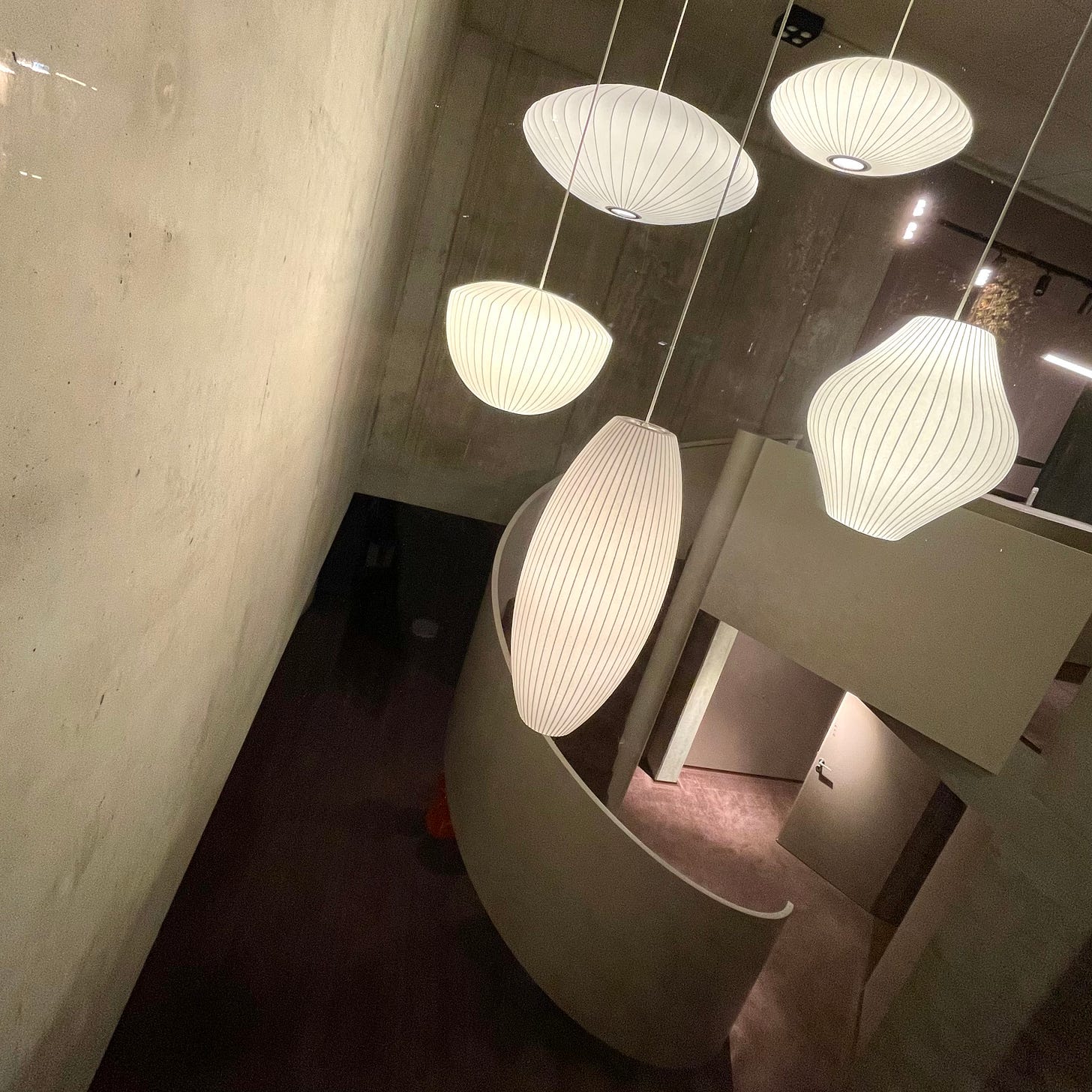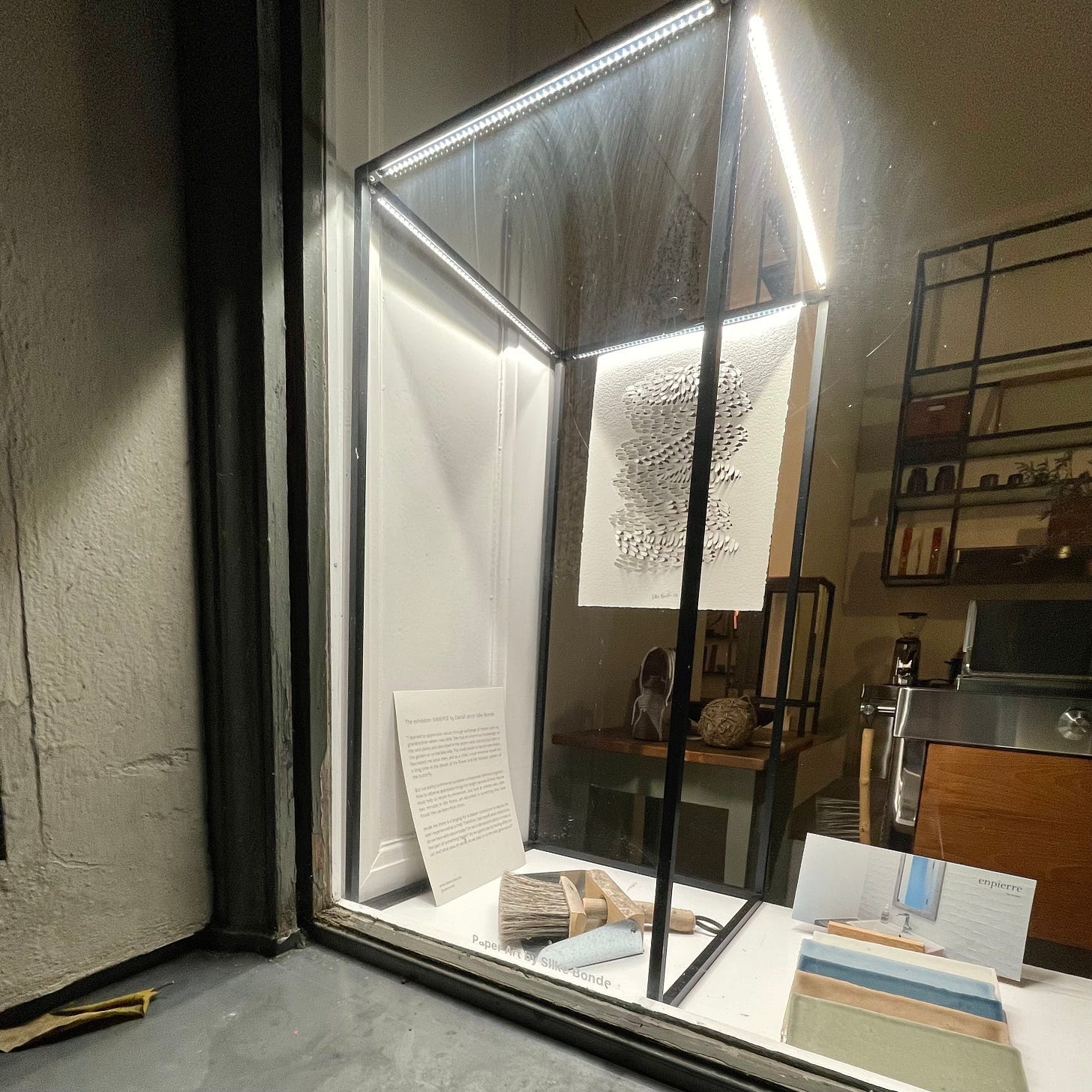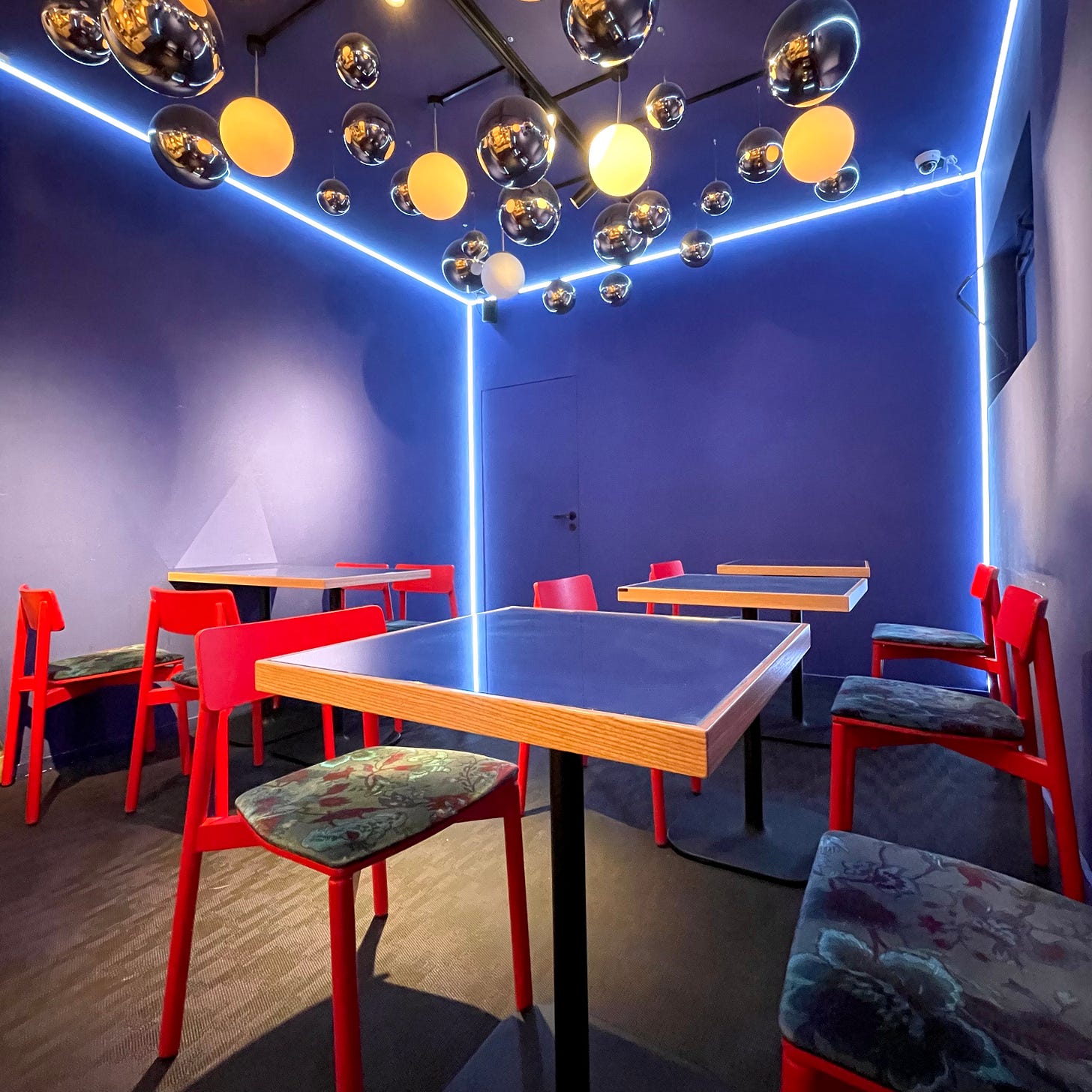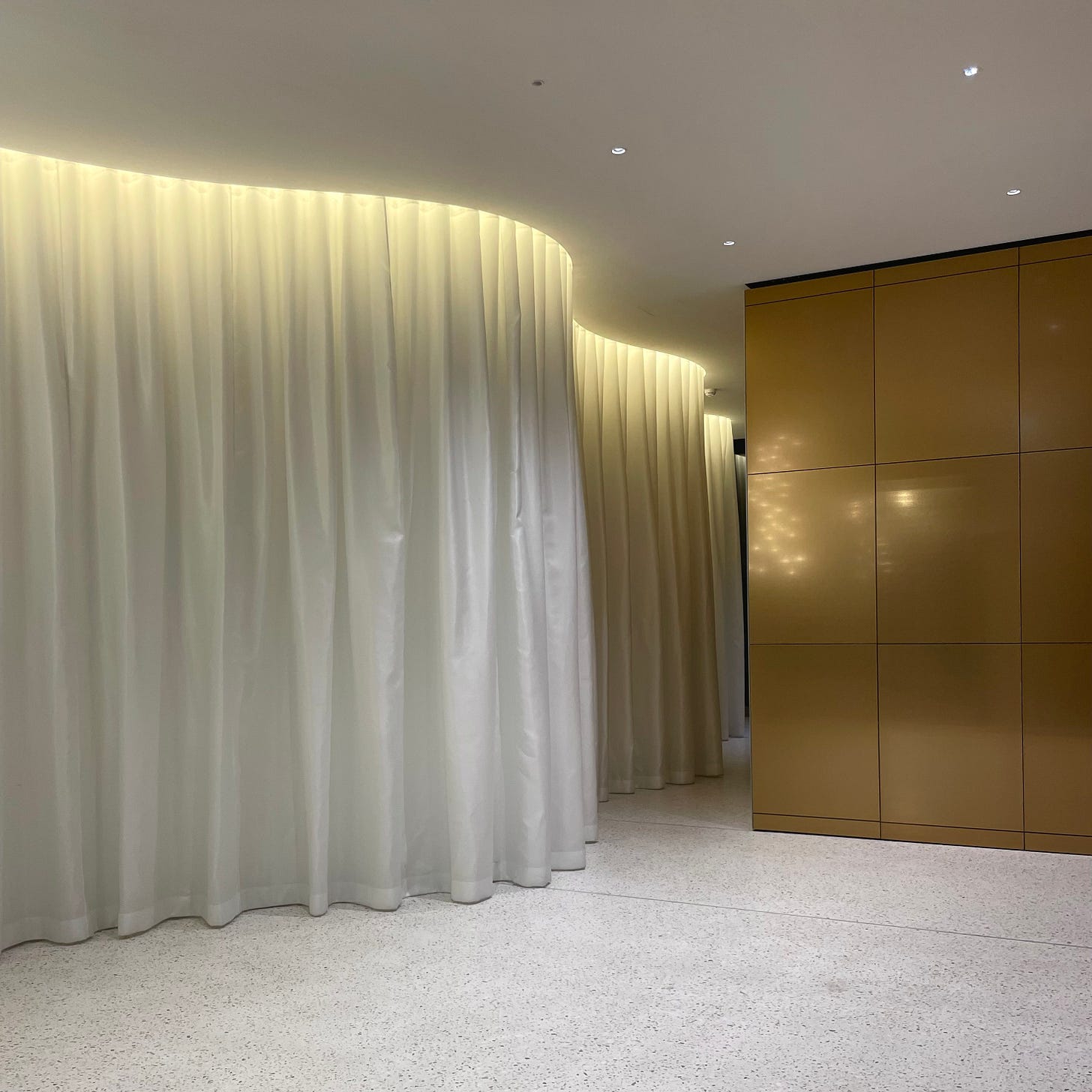Spaziergang On An Empty Canvas
disconnect 010/237
[24 November 2024]
-----------------------

Earlier this year, it must have been a day in July or August, I wanted to visit the Museum of Silence. Unfortunately, my attempt was unsuccessful. Last week, as I thought about what to do on my weekly experience-art-irl evening, I remembered the museum and decided to give it another try.
Unlike before my first try, I checked in advance to see if it was open, and I found out that it had just reopened about a week earlier. Full of vorfreude to experience art in a space dedicated to silence, I took the S-Bahn to Oranienburger Str. Under a clear sky and a full moon, I walked through a stream of cyclists likely on their way home from work, a few tourists exploring the historic neighborhood despite the already wintery temperatures, and the sometimes brightly, sometimes dimly lit windows of restaurants, bakeries, cafés, small shops, and art galleries.
I arrived at the beige, ornamented residential building where the museum is located and rang the bell. When I attempted to visit the Museum of Silence for the first time a few months ago, someone buzzed me in at the front door. After I entered, I became confused as I found myself in a typical Berlin altbau innenhof with no museum in sight, so I asked a woman who was watering some plants and seemed to live in the building for help. She told me that the entrance to the museum was through the left door on the ground floor of the vorderhaus, but unfortunately, it was temporarily closed at that moment.
To my surprise, no one buzzed me in at the main entrance of the building this time. There was a small sign in one of the ground floor windows stating that the museum had reopened on November 5 and was open until 7 PM. It was 6 PM, and I rang the bell two more times over the next five minutes or so. No one let me in - heute leider nicht.
Somewhat disappointed about my second failed attempt to visit the museum, I had to adjust my plans for the evening spontaneously. I walked back in the same direction from which I came, hoping a good alternative idea would pop into my head. After about a minute, I stopped in front of a brightly lit window filled with a variety of paintings.
While I glanced at them briefly, something else caught my attention. Something that reminded me of my philosophy of disconencting: The Art of Disappearance, written in the bottom left corner of the window. As I had a closer look, I realized that it was a public display featuring regularly changing exhibitions and installations. The current exhibition, different from what I initially thought based on its title, focused on nature and the ways in which it is disappearing.
As I observed the twenty or so paintings displayed on minimalistic, tripod-like stands, an idea struck me: tonight, I will go gallery window shopping. With numerous art galleries located in the triangle between Hackescher Markt, Rosenthaler Platz, and Oranienburger Tor, there is no need to enter a museum or gallery to experience art - I can simply wander the streets and look through the windows.
I continued my walk, excited about my alternative plan for the night, and about not knowing what I would discover. After passing by a few gallery windows and looking at artwork that didn’t evoke any particular emotions within me, I stopped in front of a shop. On the windowsill, there was a wooden Japanese bath stool. Based on what I saw behind it in the rest of the shop, it appeared to sell minimalistic, luxurious furniture.
Next to the bath stool, there was a small showcase featuring an installation that included an artfully carved sheet, a hand brush, and a dustpan, along with another sheet containing a text written by the artist, Silke Bonde.

"I learned to appreciate nature through exchange of letters with my grandmother when I was little. She had an enormous knowledge of the wild plants and described in the letters what she had just seen in the garden or on the bike ride. The small details in nature have always fascinated me since then, and as a child I could immerse myself for a long time in the details of the flower and the fantastic patter of the butterfly.
But our ability to immerse ourselves is threatened. We have forgotten how to observe and notice things for longer periods of time. Nature must help us return to immersion. Just look at children who, after two minutes in the forest, are absorbed in something they have found. We can learn from them.
Inside me there is a longing for a deeper connection to nature, the one l experienced as a child. Therefore, l ask myself, what relationship do we have with nature today? Do we understand its ability to make us feel part of something bigger? Do we appreciate its healing effect on us? And what view of nature do we pass on to the next generations?"
After letting those words sink in, I continued Silke’s thought process:
I believe that our ability to immerse ourselves depends on having sufficient space. We need more mental, physical, and temporal space that allows us to observe and get absorbed in whatever we encounter.
As those thoughts were marinating in my brain, I continued my walk. I first came across an interesting-looking but closed exhibition space named Migrant Bird Space and then paused in front of another art gallery window that had caught my attention. An army of colorful small paintings lined the walls, each one depicting the same man. Some portrayed just his face, others displayed his entire body. Across all of them were the words nicht träumen, machen – don’t dream, do.
These words pulled me away from my thoughts about Silke’s text I was deeply immersed in and I realized that I can contribute to preserving our ability to immerse ourselves: by creating art that provides the necessary space for such immersion.
I was getting hungry, so I decided to stop at the next restaurant that caught my eye. Once inside, the waitress seated me at a table in a quiet area of the restaurant where I was all by myself. It felt like a separate room, even though it wasn’t. The walls were painted in a deep royal blue, mirrors served as table tops, surrounded by bright red chairs, and discoballesque lamps hung from the ceiling. The contrast to the plain light wood and beige, quiet interior of the rest of the restaurant could hardly have been bigger.
After sitting there for ten minutes, getting absorbed in observing my surroundings, more people were being seated at the tables next to me as the restaurant became busier. As I let my gaze wander across both rooms, I realized that there were no tables occupied by someone sitting alone, except for the one I was sitting at.

While I enjoyed the tuna burger and lychee juice I ordered, my thoughts connected to my initial plan for the evening.
“This evening is a visit to my own private museum of silence,” I thought. “No talking, just observing and immersing myself in my own world. I can do whatever I want and go wherever I want, free from any expectations or influences from others that might disrupt my observations and the direction of my thoughts.”
After finishing my burger and drink, I headed to Am Tacheles, the recently constructed modern building complex at the west end of Oranienburger Straße. When a cleaning person briefly left a door open, I slipped into one of the buildings. As soon as I walked in, I paused for a moment to look around and take in the scene. The lobby strongly reminded me of the installation Spill Retina, which I had visited two months earlier.
I continued my explorations for about another hour, feeling as if I was walking through a nightly wonderland. Although I had walked around Am Tacheles before, I discovered many new fascinating places and perspectives.
I’ve often heard people criticizing modern architecture and urban design, claiming they are too blank and generic. I do not see this as a negative aspect at all. During the day, these places are crowded with people coming and going from offices, shops, and restaurants. At night, however, when few people are around, they become ideal spots to give the mind a break, allowing thoughts to roam freely without distraction.
Walking through areas filled with sleek glass and concrete buildings, expansive squares, and overall minimalistic designs allows your imagination to run wild, just like that of a child. It’s like a spaziergang on an empty canvas.

Brian Eno, pioneer of ambient music, once said:
‘Ambient music must be able to accommodate many levels of listening attention without enforcing one in particular; it must be as ignorable as it is interesting.’
I think the same applies to the often discredited modern architecture. If architecture is frozen music, it is the ambient music of urban design.
With this in mind, I would like to share another synth stem from 40 Nights in Torontowith you. Take a moment to listen, disconnect, and fully immerse yourself in your surroundings, your thoughts, or whatever you prefer.
[media unavailable]
Enjoy your day or night!
glg Soda Paapi
PS: If you have any feedback, I’m curious to hear it!
-----------------------
Did you enjoy what you read?
Join The Soda Club and receive a new episode of disconnect every other Sunday.
What are You waiting for?
Thank you for joining The Soda Club.
Check your inbox — a welcome email is on its way.
Spaziergang On An Empty Canvas
disconnect 010/237
[24 November 2024]
-----------------------

Earlier this year, it must have been a day in July or August, I wanted to visit the Museum of Silence. Unfortunately, my attempt was unsuccessful. Last week, as I thought about what to do on my weekly experience-art-irl evening, I remembered the museum and decided to give it another try.
Unlike before my first try, I checked in advance to see if it was open, and I found out that it had just reopened about a week earlier. Full of vorfreude to experience art in a space dedicated to silence, I took the S-Bahn to Oranienburger Str. Under a clear sky and a full moon, I walked through a stream of cyclists likely on their way home from work, a few tourists exploring the historic neighborhood despite the already wintery temperatures, and the sometimes brightly, sometimes dimly lit windows of restaurants, bakeries, cafés, small shops, and art galleries.
I arrived at the beige, ornamented residential building where the museum is located and rang the bell. When I attempted to visit the Museum of Silence for the first time a few months ago, someone buzzed me in at the front door. After I entered, I became confused as I found myself in a typical Berlin altbau innenhof with no museum in sight, so I asked a woman who was watering some plants and seemed to live in the building for help. She told me that the entrance to the museum was through the left door on the ground floor of the vorderhaus, but unfortunately, it was temporarily closed at that moment.
To my surprise, no one buzzed me in at the main entrance of the building this time. There was a small sign in one of the ground floor windows stating that the museum had reopened on November 5 and was open until 7 PM. It was 6 PM, and I rang the bell two more times over the next five minutes or so. No one let me in - heute leider nicht.
Somewhat disappointed about my second failed attempt to visit the museum, I had to adjust my plans for the evening spontaneously. I walked back in the same direction from which I came, hoping a good alternative idea would pop into my head. After about a minute, I stopped in front of a brightly lit window filled with a variety of paintings.
While I glanced at them briefly, something else caught my attention. Something that reminded me of my philosophy of disconencting: The Art of Disappearance, written in the bottom left corner of the window. As I had a closer look, I realized that it was a public display featuring regularly changing exhibitions and installations. The current exhibition, different from what I initially thought based on its title, focused on nature and the ways in which it is disappearing.
As I observed the twenty or so paintings displayed on minimalistic, tripod-like stands, an idea struck me: tonight, I will go gallery window shopping. With numerous art galleries located in the triangle between Hackescher Markt, Rosenthaler Platz, and Oranienburger Tor, there is no need to enter a museum or gallery to experience art - I can simply wander the streets and look through the windows.
I continued my walk, excited about my alternative plan for the night, and about not knowing what I would discover. After passing by a few gallery windows and looking at artwork that didn’t evoke any particular emotions within me, I stopped in front of a shop. On the windowsill, there was a wooden Japanese bath stool. Based on what I saw behind it in the rest of the shop, it appeared to sell minimalistic, luxurious furniture.
Next to the bath stool, there was a small showcase featuring an installation that included an artfully carved sheet, a hand brush, and a dustpan, along with another sheet containing a text written by the artist, Silke Bonde.

"I learned to appreciate nature through exchange of letters with my grandmother when I was little. She had an enormous knowledge of the wild plants and described in the letters what she had just seen in the garden or on the bike ride. The small details in nature have always fascinated me since then, and as a child I could immerse myself for a long time in the details of the flower and the fantastic patter of the butterfly.
But our ability to immerse ourselves is threatened. We have forgotten how to observe and notice things for longer periods of time. Nature must help us return to immersion. Just look at children who, after two minutes in the forest, are absorbed in something they have found. We can learn from them.
Inside me there is a longing for a deeper connection to nature, the one l experienced as a child. Therefore, l ask myself, what relationship do we have with nature today? Do we understand its ability to make us feel part of something bigger? Do we appreciate its healing effect on us? And what view of nature do we pass on to the next generations?"
After letting those words sink in, I continued Silke’s thought process:
I believe that our ability to immerse ourselves depends on having sufficient space. We need more mental, physical, and temporal space that allows us to observe and get absorbed in whatever we encounter.
As those thoughts were marinating in my brain, I continued my walk. I first came across an interesting-looking but closed exhibition space named Migrant Bird Space and then paused in front of another art gallery window that had caught my attention. An army of colorful small paintings lined the walls, each one depicting the same man. Some portrayed just his face, others displayed his entire body. Across all of them were the words nicht träumen, machen – don’t dream, do.
These words pulled me away from my thoughts about Silke’s text I was deeply immersed in and I realized that I can contribute to preserving our ability to immerse ourselves: by creating art that provides the necessary space for such immersion.
I was getting hungry, so I decided to stop at the next restaurant that caught my eye. Once inside, the waitress seated me at a table in a quiet area of the restaurant where I was all by myself. It felt like a separate room, even though it wasn’t. The walls were painted in a deep royal blue, mirrors served as table tops, surrounded by bright red chairs, and discoballesque lamps hung from the ceiling. The contrast to the plain light wood and beige, quiet interior of the rest of the restaurant could hardly have been bigger.
After sitting there for ten minutes, getting absorbed in observing my surroundings, more people were being seated at the tables next to me as the restaurant became busier. As I let my gaze wander across both rooms, I realized that there were no tables occupied by someone sitting alone, except for the one I was sitting at.

While I enjoyed the tuna burger and lychee juice I ordered, my thoughts connected to my initial plan for the evening.
“This evening is a visit to my own private museum of silence,” I thought. “No talking, just observing and immersing myself in my own world. I can do whatever I want and go wherever I want, free from any expectations or influences from others that might disrupt my observations and the direction of my thoughts.”
After finishing my burger and drink, I headed to Am Tacheles, the recently constructed modern building complex at the west end of Oranienburger Straße. When a cleaning person briefly left a door open, I slipped into one of the buildings. As soon as I walked in, I paused for a moment to look around and take in the scene. The lobby strongly reminded me of the installation Spill Retina, which I had visited two months earlier.
I continued my explorations for about another hour, feeling as if I was walking through a nightly wonderland. Although I had walked around Am Tacheles before, I discovered many new fascinating places and perspectives.
I’ve often heard people criticizing modern architecture and urban design, claiming they are too blank and generic. I do not see this as a negative aspect at all. During the day, these places are crowded with people coming and going from offices, shops, and restaurants. At night, however, when few people are around, they become ideal spots to give the mind a break, allowing thoughts to roam freely without distraction.
Walking through areas filled with sleek glass and concrete buildings, expansive squares, and overall minimalistic designs allows your imagination to run wild, just like that of a child. It’s like a spaziergang on an empty canvas.

Brian Eno, pioneer of ambient music, once said:
‘Ambient music must be able to accommodate many levels of listening attention without enforcing one in particular; it must be as ignorable as it is interesting.’
I think the same applies to the often discredited modern architecture. If architecture is frozen music, it is the ambient music of urban design.
With this in mind, I would like to share another synth stem from 40 Nights in Torontowith you. Take a moment to listen, disconnect, and fully immerse yourself in your surroundings, your thoughts, or whatever you prefer.
[media unavailable]
Enjoy your day or night!
glg Soda Paapi
PS: If you have any feedback, I’m curious to hear it!
-----------------------
Did you enjoy what you read?
Join The Soda Club and receive a new episode of disconnect every other Sunday.
What are You waiting for?
Thank you for joining The Soda Club.
Check your inbox — a welcome email is on its way.